Summary
Industry Canada has partnered with the Design Exchange (DX) and the Canadian Manufacturers and Exporters (CME) to produce Canada's first State of Design report. This unique analysis is intended to help Canadian PD&D executives as well as decision makers understand current market trends and recognize the advantages of investing in PD&D to improve business competitiveness.
- State of Design: The Canadian Report 2010 (PDF,1,626 KB, 30 pages)
- Permission to reproduce
Highlights
In today's complex business environment, the extent to which firms invest in product design and development (PD&D) is a key determinant of their competitiveness. In general, Canadianfirms that invest more in PD&D generate additional business benefits from new or significantly improved products, including increased revenue and improved access to new export markets.1
Investment in PD&D by firms can be done either in-house or through outsourcing to PD&D service providers. The PD&D service industry is a technologically vibrant part of the Canadian service economy that supplies critical innovation services to other sectors, notably manufacturers, distributors, and retailers. PD&D serves as a link between creativity, innovation, and commercialization; a clear understanding of the trends and importance of PD&D as a value-addedservice activity is essential.
Industry Canada has partnered with the Design Exchange (DX) and the Canadian Manufacturersand Exporters (CME) to review the valuable service business function of PD&D. By collecting insights from the industry and international research organizations, and using economic modelling conducted by Industry Canada, this industry–government collaboration has produced a complete user/service provider profile of PD&D in Canada, summarized here in this report. This unique analysis is intended to help Canadian PD&D executives as well asdecision makers understand current market trends and recognize the advantages of investing in PD&D to improve business competitiveness.
Key Findings:
- Main PD&D drivers include meeting changing customer preferences and shortening time to market windows.
- In the manufacturing and services sectors, PD&D occupations command nearly a 50 percent wage premium over the economy average.
- PD&D outsourcing to service providers is forecasted to increase by 20 percent by 2012 to $10.6 billion.
- The export intensity of Canadian product design service providers is 2.25 times greater than that of the United States.
- The adoption rates of advanced PD&D technologies are similar between small, medium, and large firms. However, fewer small and medium firms adopt PD&D processes compared to large firms.
- Regardless of business size, over 80 percent of Canadian firms report a significant improvement in the satisfaction of client needs and product quality as a result of adopting advanced PD&Dtechnologies and processes.
Background
In a global economy, the extent to which Canadian firms invest in product design and development (PD&D) is a key determinant of their competitiveness, as it allows them to introducenew and innovative products to market. PD&D is a process that links the generation of new ideas and concepts (creativity) to the creation of new products (innovation) and can be done by either manufacturers or service providers. The PD&D process is a cycle of continuousimprovement over time with iterative feedback and recurring input from all development team members. The PD&D cycle involves six stages: assess opportunity; strategize; conceptualize; develop; implement; and launch (Figure 1).
Figure 1: Product design and development cycle2
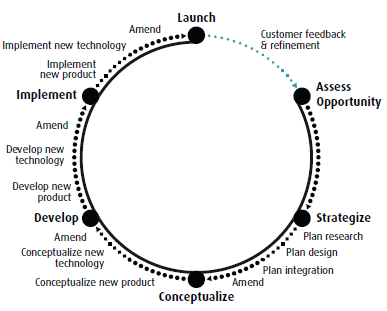
The process begins with an assessment of opportunity, such as an unmet consumer need, to determine whether a new product idea is viable for a company. In the strategize stage, the development team will assess what resources are required and carry out design research. Following this are the conceptualize and develop stages where mock–up, product evaluation, modelling, prototyping/testing, and refinement activities are completed. Once a product has been successfully designed it is then integrated into the production process in the implement stage, where detailed specification and coordination activities take place. Ultimately, the new product is then promoted and launched in the marketplace. A key component of the PD&D cycle is consumer feedback and refinement following the launch of the product. This processleads to improvements and new opportunities for the next iteration of the cycle.2
Canadian manufacturers and service providers can benefit from quality and timely information on PD&D trends and performance indicators. This strategic information can also be used to identify best practices, develop benchmarks, justify investment and innovation decisions, and help inform policy makers of current and future industry needs.
This report provides insights on:
- Current pressures driving firms to invest in PD&D;
- PD&D investment by industrial sectors in 2008;
- Growth forecast of PD&D outsourcing up to 2012;
- PD&D service industry profile: geographic distribution, revenue and export intensity;
- Skills and employment;
- Adoption of advanced PD&D technologies and processes; and
- Business benefits of adopting advanced PD&D technologies and processes.
Approach and methodology
This report is based on a collaborative undertaking between the Design Exchange (DX),Canadian Manufacturers and Exporters (CME) research committee, and Industry Canada's Service Industries and Consumer Products Branch. The DX/CME research committee defined industry needs, drivers, and metrics and offered valuable insights from an industry perspective. By using information from industry partners and international research organizations, and by applying unique economic models developed in–house, Industry Canada provided the overall analysis and brought together all the components needed to produce Canada's first State of Design report.
Product design and development drivers
Several pressures are driving firms to invest in PD&D to create innovative products. Ingeneral, North American firms perceive changing customer preferences and shorteningtime to market windows as the main drivers to invest in PD&D (Figure 2). Consumer preferences often dictate innovation as firms strive to deliver timely products to satisfy the changing needs of consumers. In addition, time to market windows are becoming tighter as businesses seek to launch products ahead of their competitors to capture increased marketshare and higher margins. There are also internal pressures prompting firms to invest inPD&D such as the need to control product and technology development costs.3
Figure 2: Top Drivers for PD&D Investment3
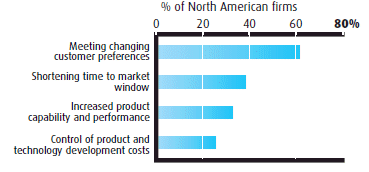
With numerous pressures driving firms to invest in PD&D, diverse design requirementsmust be balanced in the strategize, conceptualize, and develop stages of the PD&D process.For this reason, many firms use Design for X (DfX) tools within their PD&D processes.In general, DfX is an approach to PD&D directed at maximizing the product requirementsdemanded (such as assembly, quality, disassembly, manufacturability, safety, and environmentalfriendliness) and simultaneously minimizing cost.4 As an example, with increased consumer concern for the environment, some Canadian firms are implementing Design forEnvironment (DfE) practices within their operations to meet changing consumer preferences while increasing access to foreign markets and decreasing costs.Footnote A
PD&D is not without challenges. One key difficulty is to minimize the gap between the design and engineering departments. The voice of the customer needs to carry through tothe end product, while the product itself must be manufacturable and meet productioncost targets. Another substantial challenge lies in making the PD&D process seamless withminimal time and expense spent modifying the design. Iterations are a natural part of theprocess; however, correcting problems in the early stages is optimal.2
The details of a PD&D process are industry– and firm–specific. However, several core approaches to PD&D are central to industrial goods manufacturers and demonstrate theimportance of PD&D to the success of a firm. One major approach to PD&D is Design forManufacturing and Assembly (DFMA), which focuses on making production as easy and economical as possible in the design stage. This can include designing a product to have fewer parts overall and more standardized parts and materials. Other guidelines within the DFMAapproach include designing for parts orientation and handling to minimize effort in adjustingand merging parts, and designing for ease of fabrication. A focus on DFMA can significantly improve the manufacturing process by reducing assembly time and costs.4
Another approach to PD&D is to take a broader perspective and identify the needs of all stakeholders, including those of the end user, the manufacturer(s), sales, retail, marketing, and regulatory compliance. Common ground and priorities are established and agreed to, and PD&D efforts are then focused on generating solutions that best satisfy the range of requirements.2
Product design and development (PD&D) investment
Investment in PD&D by firms can either be done in–house or through outsourcing. In–house PD&D is defined as the internal investment that a sector makes in terms of the personnel and capital related to PD&D. Outsourced PD&D is defined as the purchase of PD&D services from service providers in Canada or abroad. Two measures present a comprehensive view of PD&D in Canada: absolute dollars represent the PD&D investment volume, and intensity represents the importance of PD&D to individual industrial sectors.
PD&D investment—volume
In 2008, the Canadian manufacturing sector invested $38.6 billion in PD&D. Of this investment, 26 percent was outsourced to PD&D service providers.Footnote B In terms of manufacturing sectors, the industrial electronics industry is the largest PD&D investing sector in Canada with approximately $5.4 billion in 2008, followed by the motor vehicle, chemical, and machinery industries, with approximately $3.9, $3.3 and $3.1 billion, respectively (Figure 3).
Figure 3: PD&D Investment Volume—20085

PD&D investment — intensity
PD&D investment intensityFootnote C is a measure of how critical PD&D is to a particular industry.Footnote DThe variability of PD&D intensity across industries is influenced by different market structures,levels of competition and business models. For example, the industrial electronics industryis characterized by the need for highly specialized skills and substantial costs of investment.Driven by a desire for market control in a competitive market structure, firms within thisindustry focus PD&D investments on developing breakthrough technological innovations andimproved product architecture.2
The shift in industry ranking between PD&D investment intensity and dollars invested is notable. For example, even though the electrical equipment and aerospace industries have relatively low investment volumes in PD&D, the importance of product introduction andimprovement is signified by their high investment intensity (Figure 4). In the aerospaceindustry new products are highly complex and require a long PD&D cycle to develop; as aresult, aerospace firms invest continuously in PD&D.
Figure 4: PD&D Investment Intensity—20085
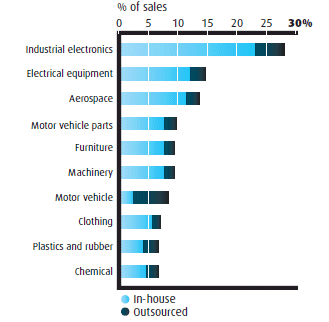
The Canadian furniture industry also has a high PD&D investment intensity even though theindustry invests a small amount in absolute terms. Many office furniture manufacturers areinvesting in PD&D, have a large design–oriented focus, and are developing mass customization/design solutions for their customers, as a means to differentiate themselves from producers whorely on lower labour costs.2
PD&D Outsourcing
At the macro level, the manufacturing sector in Canada conducts the majority of its PD&Din–house. In contrast, the motor vehicle sector outsourced 76 percent of its PD&D activities tosuppliers and service providers — significantly more than the outsourcing average of 26 percent(Figure 5). For Canadian automotive manufacturers, 97 percent of outsourced activity is PD&D engineering services required to integrate new product line requirements from supply chain partners, while the remainder is computer systems and software development.5 Conversely,most PD&D performed by motor vehicle parts manufacturers is done in–house once product specifications are delivered by the original equipment manufacturers.2
Figure 5: PD&D Investment Model—20085

In 2008, as risk spread from the financial to non–financial sectors, firms postponed theirintended outsourcing investments to remain solvent. Prior to this decrease, the expansion ofthe global economy had generated many successful product lines. During the recent economicdownturn, the overarching PD&D strategy for many firms has been to reduce costs of existing products without introducing new discretionary features in response to price–sensitive markets. With this objective, constrained firms naturally reduce their PD&D investment levels.2
As firms begin to rebuild their financial positions and regain confidence in the market, PD&D investment strategies shift to enhanced cost reductions and new product introductions. As early adoptersFootnote E re–enter the market, firms compete again with new features as differentiating factors.2 By 2012, PD&D outsourcing by Canadian firms to service providers is expected torebound strongly and increase by 20 percent to $10.6 billion (Figure 6).
Figure 6: Forecast of PD&D Outsourcing (2005 to 2012)6
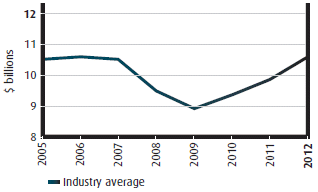
This forecasted growth in PD&D outsourcing is expected to be driven mainly by industrial goods sectors. The aerospace, electrical equipment, fabricated metal, motor vehicle part, and wood product industries are expected to increase their PD&D outsourcing activities by over 10 percent per year (Figure 7).
Figure 7: Product Design and Development by Industry (2009 to 2012)
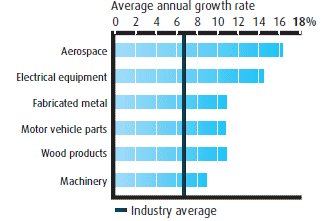
Intellectual property rights
A greater proportion of Best-in-Class firmsFootnote F adopt measures to ensure the legal protectionof intellectual property (IP). Different methods exist to prevent imitation and protect ideas; examples include, but are not limited to, confidentiality agreements, secrecy, and patents. As a result of securing IP protection, firms have greater ability to protect their competitive advantage of being first to market.
Figure 8: Use of Intellectual Property

In addition, securing intellectual property rights (IPRs) has become an important aspect of outsourcing between manufacturers and PD&D service providers, as 68 percent of North American firms perceive an increased risk to their product IP protection due to the globalization of markets.8
Service providers can assist businesses in protecting IP by specifying ownership of the IPRat the onset of a project. For example, service providers can agree to assign IPRs after the contract's completion; this means that the IPR is assigned to the service provider for the durationof the outsourcing contract and will transfer back to the customer upon completion ofthe project. Under this arrangement, the service provider may cooperate in preparing patentapplications or can maintain the PD&D process as a trade secret.8
The Product design and development service industry
The PD&D service industry is an important part of the Canadian service economy that supplies critical innovation services to many other industries such as manufacturing, distribution, and retail. The PD&D industry is primarily engaged in developing professional designs andspecifications through a pragmatic development approach that optimizes the function, value,usability and appearance of products. These services can include material selection, construction,mechanisms, shape, and surface finishes of the product, taking into account a host ofconsiderations such as human needs, safety, the environment, development timeline, productioncost, maintenance, and distribution.9
For the purpose of this report, the PD&D industry is categorized into two broad sub-sectors: product design services and product testing services.
- The product design category includes two industries — industrial design and consumerfashion design services:
- The industrial design industry is engaged in creating and developing designs andspecifications that optimize the function, value and appearance of products.
- The consumer fashion design industry is engaged in clothing, jewellery, shoe, textile, andgeneral fashion design services.
- Product testing service firms are engaged in providing physical, chemical and otherproduct–related testing services.
Geographic distribution
In 2008, the majority of PD&D service providers were located in central and western Canada with approximately 2,400 establishments in Ontario, 1,000 in Quebec, 1,900 in Alberta, and 980 in British Columbia (Figure 9). Most PD&D service firms are small in size — between1 and 19 employees — with a number of them focusing on only providing upfront strategicPD&D planning and assessment services; a high value-added activity for their customers'business strategy.2
Figure 9: Geographic Distribution of Product Design and Development Service Providers10
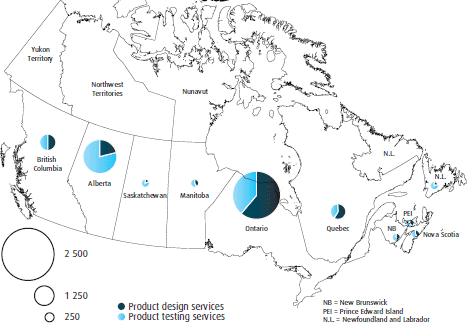
The highest concentrationsFootnote G of PD&D service providers are found near large metropolitan areas. The most geographically concentrated regions are located around Montréal, Toronto,Calgary, and Vancouver — all of which have strong design communities (Figure 10).
Figure 10: Geographic Concentration of Product Design and Development Service Providers10
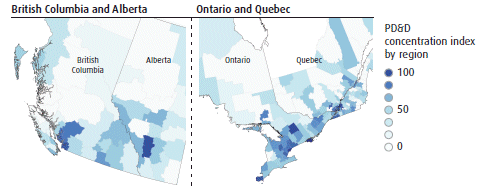
Between 2000 and 2008, some product design firms have consolidated, boosting the numberof medium and large firms in Canada. This is partly due to the fact that some Canadian serviceproviders are seeking to be total package providers and offer a full spectrum of design services— not uncommon considering the most commercially successful design service providers in theUnited States, United Kingdom, Italy, and France operate as total package providers.2 Firms are increasingly seeking complete design service solutions to avoid scattering their outsourcing contracts across too many channels and to minimize transaction costs.11
Performance Footnote H
The Canadian product design service industry has outperformed the Canadian economyby 60 percent in terms of revenue growth over the 1999 to 2007 period. Revenue for the Canadianconsumer fashion design sector has increased by 10 percent a year over the same period, and revenuegrowth for industrial design services has also been strong with average annual growth of 9 percent(Figure 11). Also in 2007, the industrial design and consumer fashion design industries hadprofit margins of approximately 12 percent and 11 percent, respectively.12
Figure 11: Product Design Industry Revenue Growth (1999 to 2007)12

With a relatively small domestic market, Canadian design firms focus more on exportingtheir services compared to U.S. design service providers. In fact, the export intensityFootnote I ofCanadian product design industry is 2.25 times greater than U.S. firms, with exports totalling$83 million in 2007 (Figure 12).
Figure 12: Product Design Industry Export Intensity 200713
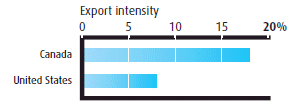
The majority of Canadian product design services exports are to the United States, witha large proportion being industrial design, product modelling, and prototyping services. Asizable portion of design exports to other markets are clothing, textile, and jewellery designservices. The industrial design service industry exports 78 percent of its services to the United States and an additional 7 percent to Mexico. The consumer fashion design service industry is focused more on export markets outside of North America (Figure 13).
Figure 13: Product Design Industry Export Destinations 200712
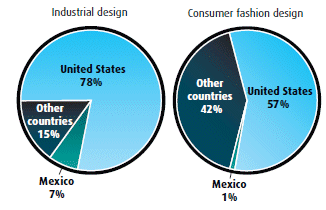
Employment and skills
The PD&D process requires a wide range of highly advanced skills throughout its six stages. Approximately 225 000 people are employed in PD&D occupations within the manufacturingand PD&D service sectors.14 The largest share of employment is in technical and scientific occupations. In addition, a large base of product engineers is employed within the process (Figure 14).
Figure 14: Composition of Product Design and Development Occupations 2008
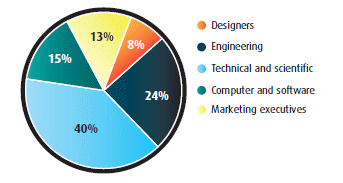
From 1997 to 2001, PD&D employment increased by 25 percent to 245 000. Over this period, employment within the PD&D service industry — which encompasses 15 percent of total PD&D employment — grew by 77 percent, while PD&D employment in the manufacturing sector increased by 20 percent. Following this period, PD&D employment has remained stable in Canada with slightcyclical changes (Figure 15).
Figure 15: Product Design and Development Employment (1997 to 2008)
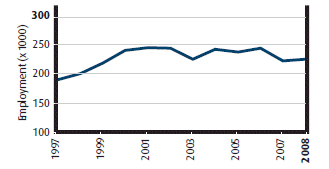
The PD&D process also requires highly educated employees. In fact, 47 percent require either a university or a college degree, and another 41 percent of PD&D occupations require at least a universityeducation. As a result, PD&D occupations command close to a 50 percent wage premium over the economy average, with yearly salaries averaging $60 700 and $62 600 within the manufacturing and the PD&D service sector, respectively (Figure 16).
Figure 16: Product Design and Development Employment (1997 to 2008)
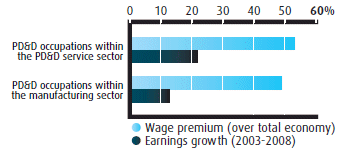
Product design and development (PD&D) innovation
Canadian firms are changing the way they conduct PD&D to better respond to the challenges of product innovation; as a result, firms are improving their business performance. Innovationin the PD&D process is captured in two ways: the adoption of advanced PD&D technologies,and the use of new PD&D processes. For the purpose of this report, advanced PD&D technologies include virtual product development and rapid prototyping, and PD&D processes include concurrent design/engineering, cross–functional design teams, and e–based design/engineering processes.
- Virtual product development (VPD) refers to the use of simulation software or servicesthroughout the PD&D process.
- Rapid prototyping refers to the use of additive fabrication technologies that facilitate the construction of a 3D model of a physical object directly from a computer–aided design (CAD) file in a relatively short amount of time compared to traditional prototyping methods.
- Concurrent design/engineering refers to design and engineering activities conductedsimultaneously — rather than sequentially — with design work and other developmental processes.
- Cross–functional design teams are defined as groups that include people from all relevant functional areas responsible for PD&D, with customized teams often assembled on a per–project basis.
- E–based (online) design/engineering consists primarily of a service derived from an e–sourcing–based solution. Items can include electronic forms and custom programs. This involves the use of electronic techniques to carry out business transactions, including electronic mail or messaging,internet technology, electronic bulletin boards, purchase cards, electronic funds transfers andelectronic data interchange.
Advanced PD&D technology adoption
Virtual product design (VPD) and rapid prototyping enable firms to perform faster product iterations to meet shrinking time to market windows. Notably, the top adopters of advanced PD&D technologies are industrial product sectors, as opposed to consumer products. The adoption of advanced PD&D technologies and the technology mix vary greatly by industry.15 For example, the use of VPD technologies in the aerospace industry is more common than rapid prototyping. For this industry, VPD includes digital pre-assembly and 3D build simulation — much more efficient than large–scale physical mock–ups (Figure 17).
Figure 17: Advanced Product Design and Development Technology Adoption
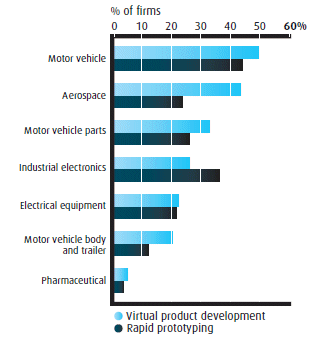
Conversely, the use of rapid prototyping technology is more common in the industrialelectronics industry. The ability to conduct rapid prototyping with key partners — includingsuppliers — is essential for market leadership. Rapid prototyping allows the construction ofphysical prototypes quickly, depending on part size and complexity, which traditionally cantake weeks or months.16
PD&D process adoption
Compared to the adoption of advanced PD&D technologies, the adoption of organizational processes across industries is more consistent. The top three industries with the highest adoption rate of cross–functional design teams are motor vehicle, motor vehicle parts, and industrial electronics (Figure 18).
Figure 18: Product Design and Development Process Adoption
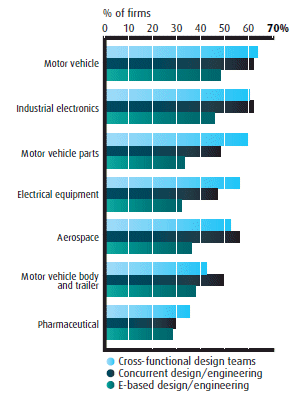
The top three industries with the highest adoption rate of concurrent design/engineeringprocesses are the motor vehicle, industrial electronics, and aerospace sectors. Different decision–makers in the PD&D process — for example, product designers or manufacturers — have their own sets of requirements to fill, while maintaining the overarching objective of maximizing end–user satisfaction. Concurrent design/engineering, as a more cost–effective and efficient design method, essentially facilitates the optimization of different design parameters, such as product performance and product manufacturing cost. E–based design or engineeringis an emerging process innovation that helps leverage cross–functional design teams andconcurrent design/engineering, interconnecting global supply chain partners. Although the adoption of e–based design is currently lower than other PD&D processes, it is expected to bemore prevalent in the near future.2
Benefits of advanced PD&D technology and process adoption
For this report, reduced time to market (defined as the time required from conceptualizationof a product idea to readiness for distribution) and improved satisfaction of client needswere chosen as key business benefits resulting from adopting advanced PD&D technologies andprocesses. These two dimensions quantify the extent to which advanced PD&D technologies and processes enable firms to react to top PD&D drivers: a firm's response to pressure to meetchanging customer preferences can lead to improved satisfaction of client needs, while the firm'sresponse to shrinking time to market windows can reduce that firm's own time to market.
As a result of adopting advanced PD&D technologies and processes, 84 percent of Canadian manufacturers on average are seeing significant improvement in the satisfaction of their client needs and 66 percent are reducing their time to market.15
Advanced PD&D technologies can help firms improve the satisfaction of their client needs in two ways. The technologies can be used to validate design in the early stages of the PD&Dprocess to detect errors and flaws, and they can be used to prevent miscommunication ofdesign concepts — especially with increasing product complexity and cost pressures.17
Figure 19: Benefits of Advanced Product Design and Development Technology and Process Adoption
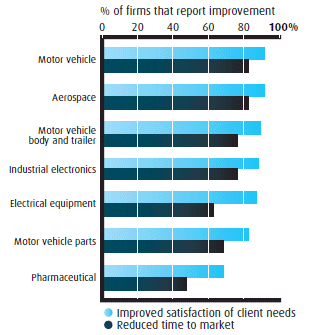
Across Canadian manufacturing sectors that adopt advanced PD&D technologies, improved client satisfaction is more commonly achieved as a business benefit than reduced time to market (Figure 19). Advanced PD&D technologies and processes also generate more conventionalbenefits such as new product features and improved product quality. Of advanced PD&D technology and process adopters, 87 percent report a significant improvement in product quality and 67 percent report improvement in new product features.Footnote J
Size of firm analysis
Compared to large–scale businesses, fewer small– and medium–sized firms (SMEs) are adopting PD&D processes.Footnote K For example, large firms are 28 percent more likely to utilize concurrent design/engineering techniques compared to small firms and are 41 percent more likely to use cross–functional design teams (Figure 20). SMEs are less likely to implement concurrent design/engineering since the process is most effective when applied to long and complex PD&D cycles — an attribute more common in large firms. As a corollary, SMEs also adopt cross–functionaldesign teams less as it is often a prerequisite for concurrent design/engineering.
Interestingly, the adoption rates of advanced PD&D technologies are similar between small,medium and large firms (Figure 20). The main reason for this is the recent introduction of morecost–effective solutions accessible to SMEs. Rapid prototyping has become more cost–effective through the introduction of affordable 3D printer technology, which can be one–tenth the cost of more sophisticated rapid prototyping options.2 Also, affordable virtual product developmenttechnologies are available including cost–effective visualization, simulation, and 3D collaborationtools.2
Figure 20: Adoption of Advanced Product Design and Development Technology and Process–Business Size

The adoption of advanced PD&D technologies is less prevalent than PD&D processes ingeneral. Since PD&D is done collaboratively with many supply–chain partners, each partner must adopt the same process to coordinate successfully. However, it is not necessary for all the partners to adopt advanced PD&D technologies since a limited number of PD&D project contributors are usually responsible for prototyping and virtual product development.2
Small–, medium–, and large–scale Canadian firms perceive similar business benefits fromadopting advanced PD&D technologies and processes. Regardless of business size, over 80 percent of Canadian firms report a significant improvement in the satisfaction of client needs and product quality (Figure 21).
Figure 21: Benefits of Advanced Product Design and Development Technology and Process Adoption–Business Size
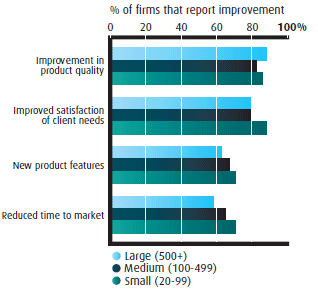
However, a greater proportion of SMEs report a reduction in time to market (Figure 21). Reducing their time to market helps SMEs further enhance their lead–time advantage on which they rely more to protect their IP compared to patents, confidentiality agreements, or secrecy.2
Final remarks
Product Design and Development (PD&D) is an essential discipline that helps firms create, innovate, and commercialize. The process involves interplay between design, engineering, scientific research, and business strategy forming a systematic approach integrating holistic–thinking, research methods, and strategic planning. It is an integral part of manufacturers' operations, with Canadian manufacturers investing $38 billion in 2008. Canada's vibrant PD&D service sector provides business services to Canadian manufacturers and clients abroad. The performance of the product design industry has been very strong, with above–average revenue and wage growth.
In both the manufacturing and services sectors, the process of PD&D employs 225 000 highly skilled workers who earn nearly a 50 percent wage premium for providing value–added business services that can improve a firm's competitiveness and its ability to adapt to changing market conditions.
For policy makers, the findings presented in this report draw important linkages between thedrivers for investing in PD&D, innovation, firm activities, and resulting business benefits. These connections can help inform a continued dialogue across government and with stakeholders. This report also sets the stage for those interested in PD&D trends to pursue new researchopportunities and projects.
Annex I: Tables
- 2008 PD&D Investment
- Advanced PD&D Technology Adoption
- PD&D Process Adoption
- Benefits of Advanced PD&D Technology and Process Adoption
| ($ billions) | (% of sales) | |||||
|---|---|---|---|---|---|---|
| In–house | Outsourced | Total | In–house | Outsourced | Total | |
| Source: Industry Canada. Economic modelling based on data from Statistics Canada (Census, LFS and Input–Output tables), 2009. | ||||||
| Total manufacturing | 28.29 | 10.38 | 38.67 | 4.7% | 1.7% | 6.4% |
| Industrial electronics | 4.43 | 0.93 | 5.36 | 23.1% | 4.8% | 27.9% |
| Motor vehicle | 1.02 | 2.85 | 3.87 | 2.2% | 6.0% | 8.2% |
| Chemical | 2.33 | 1.03 | 3.35 | 4.5% | 2.0% | 6.6% |
| Machinery | 2.52 | 0.55 | 3.07 | 7.5% | 1.6% | 9.2% |
| Aerospace | 2.14 | 0.37 | 2.51 | 11.6% | 2.0% | 13.6% |
| Motor vehicle parts | 1.64 | 0.44 | 2.08 | 7.5% | 2.0% | 9.5% |
| Primary metal | 1.73 | 0.32 | 2.05 | 3.1% | 0.6% | 3.7% |
| Fabricated metal | 1.51 | 0.36 | 1.87 | 4.1% | 1.0% | 5.1% |
| Paper | 1.39 | 0.35 | 1.74 | 4.8% | 1.2% | 5.9% |
| Plastics and rubber | 0.91 | 0.65 | 1.56 | 3.9% | 2.8% | 6.6% |
| Electrical equipment | 1.26 | 0.25 | 1.51 | 12.1% | 2.4% | 14.5% |
| Petroleum and coal | 1.02 | 0.36 | 1.38 | 1.3% | 0.4% | 1.7% |
| Food | 0.65 | 0.62 | 1.27 | 0.8% | 0.8% | 1.6% |
| Furniture | 1.01 | 0.21 | 1.23 | 7.7% | 1.6% | 9.3% |
| Printing and related support activities | 0.66 | 0.19 | 0.85 | 6.3% | 1.8% | 8.0% |
| Wood | 0.56 | 0.22 | 0.78 | 2.6% | 1.0% | 3.6% |
| Beverage and tobacco | 0.44 | 0.22 | 0.66 | 4.1% | 2.1% | 6.2% |
| Non–metallic mineral | 0.21 | 0.14 | 0.35 | 1.5% | 1.0% | 2.4% |
| Clothing | 0.18 | 0.05 | 0.23 | 5.5% | 1.4% | 6.9% |
| Motor vehicle body and trailer | 0.16 | 0.03 | 0.18 | 4.2% | 0.7% | 4.9% |
| Computer–aided design (CAD) | Electronic exchange and management of CAD files | Rapid prototyping | Virtual product development | |
|---|---|---|---|---|
| Source: Statistics Canada. Customized tabulation from the Survey of Advanced Technology, 2007. | ||||
| Total manufacturing | 51% | 44% | 14% | 15% |
| Motor vehicle | 100% | 82% | 44% | 49% |
| Aerospace | 85% | 89% | 24% | 43% |
| Motor vehicle parts | 77% | 73% | 26% | 33% |
| Industrial electronics | 76% | 65% | 36% | 26% |
| Electrical equipment | 72% | 58% | 22% | 22% |
| Motor vehicle body and trailer | 68% | 52% | 12% | 20% |
| Pharmaceutical | 29% | 27% | 3% | 4% |
| Concurrent design / engineering | Cross–functional design teams | E–based (online) design or engineering | |
|---|---|---|---|
| Source: Statistics Canada. Customized tabulation from the Survey of Advanced Technology, 2007. | |||
| Total manufacturing | 36% | 50% | 11% |
| Motor vehicle | 62% | 64% | 48% |
| Industrial electronics | 62% | 60% | 45% |
| Aerospace | 57% | 52% | 36% |
| Motor vehicle body and trailer | 49% | 42% | 37% |
| Motor vehicle parts | 48% | 60% | 33% |
| Electrical equipment | 47% | 56% | 32% |
| Pharmaceutical | 29% | 35% | 28% |
| (% of firms that report improvement) | ||||
|---|---|---|---|---|
| New product features | Improvement in product quality | Reduced time to market | Improved satisfaction of client needs | |
| Source: Statistics Canada. Customized tabulation from the Survey of Advanced Technology, 2007. | ||||
| Total manufacturing | 69% | 86% | 67% | 85% |
| Motor vehicle | 100% | 95% | 82% | 91% |
| Industrial electronics | 81% | 91% | 76% | 88% |
| Electrical equipment | 74% | 79% | 61% | 86% |
| Aerospace | 72% | 85% | 82% | 90% |
| Motor vehicle parts | 72% | 89% | 67% | 82% |
| Motor vehicle body and trailer | 66% | 87% | 76% | 89% |
| Pharmaceutical | 43% | 89% | 46% | 67% |
Footnotes
- Footnote 1
See Industry Canada's Design for Environment: Innovating to Compete for a complete overview of the use of DfE practices and their business benefits for Canadian firms.
- Footnote 2
For a detailed breakdown of PD&D investment, see Annex I.
- Footnote 3
PD&D investment intensity is defined as PD&D investment divided by sales.
- Footnote 4
For a detailed breakdown of PD&D intensity, see Annex I.
- Footnote 5
Early adopters are consumers who place a premium on the early procurement of a new product.
- Footnote 6
Best-in-Class firms are defined as those that generate more than 35 percent of their revenue from new or significantly improved products.
- Footnote 7
Concentration is defined as the number of PD&D service providers divided by the total number of all business establishments in a geographical location.
- Footnote 8
Due to data availability, this section does not cover product testing laboratories.
- Footnote 9
Export intensity is defined as export revenue divided by total revenue.
- Footnote 10
See Annex I for a detailed breakdown of PD&D technology/process adoption and benefits.
- Footnote 11
Small–, medium–, and large–scale businesses are defined as companies with 20 to 99 employees, 100 to 499 employees, and over 500 employees, respectively.
Permission to reproduce:
Non-commercial reproduction
Except as otherwise specifically noted, the information in this publication may be reproduced, in part or in whole and by any means, without charge or further permission from Industry Canada, provided that due diligence is exercised in ensuring the accuracy of the information reproduced; that Industry Canada is identified as the source institution; and that the reproduction is not represented as an official version of the information reproduced, nor as having been made in affiliation with, or with the endorsement of Industry Canada.
Commercial Reproduction
For permission to reproduce the information in this publication for commercial purposes,
please contact the:
Web Services Centre
Industry Canada
C.D. Howe Building
235 Queen Street
Ottawa, Ontario Canada
K1A 0H5
Telephone (toll-free in Canada): 1-800-328-6189
Telephone (Ottawa): 613-954-5031
Fax: 613-954-2340
TTY (for hearing-impaired): 1-866-694-8389
Business hours: 8:30 a.m. to 5:00 p.m. (Eastern Time)
Email: ic.info-info.ic@canada.ca
© Her Majesty the Queen in Right of Canada,
represented by the Minister of Industry, 2012
Cat. No.: Iu44-79/2010
ISBN: 978-1-100-51148-1
IC registration #: 60712
Aussi offert en français sous le titre L'état de la conception de produits : Le rapport canadien 2010
